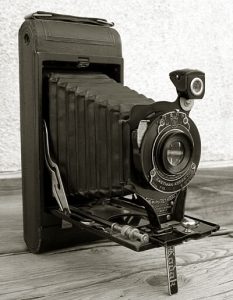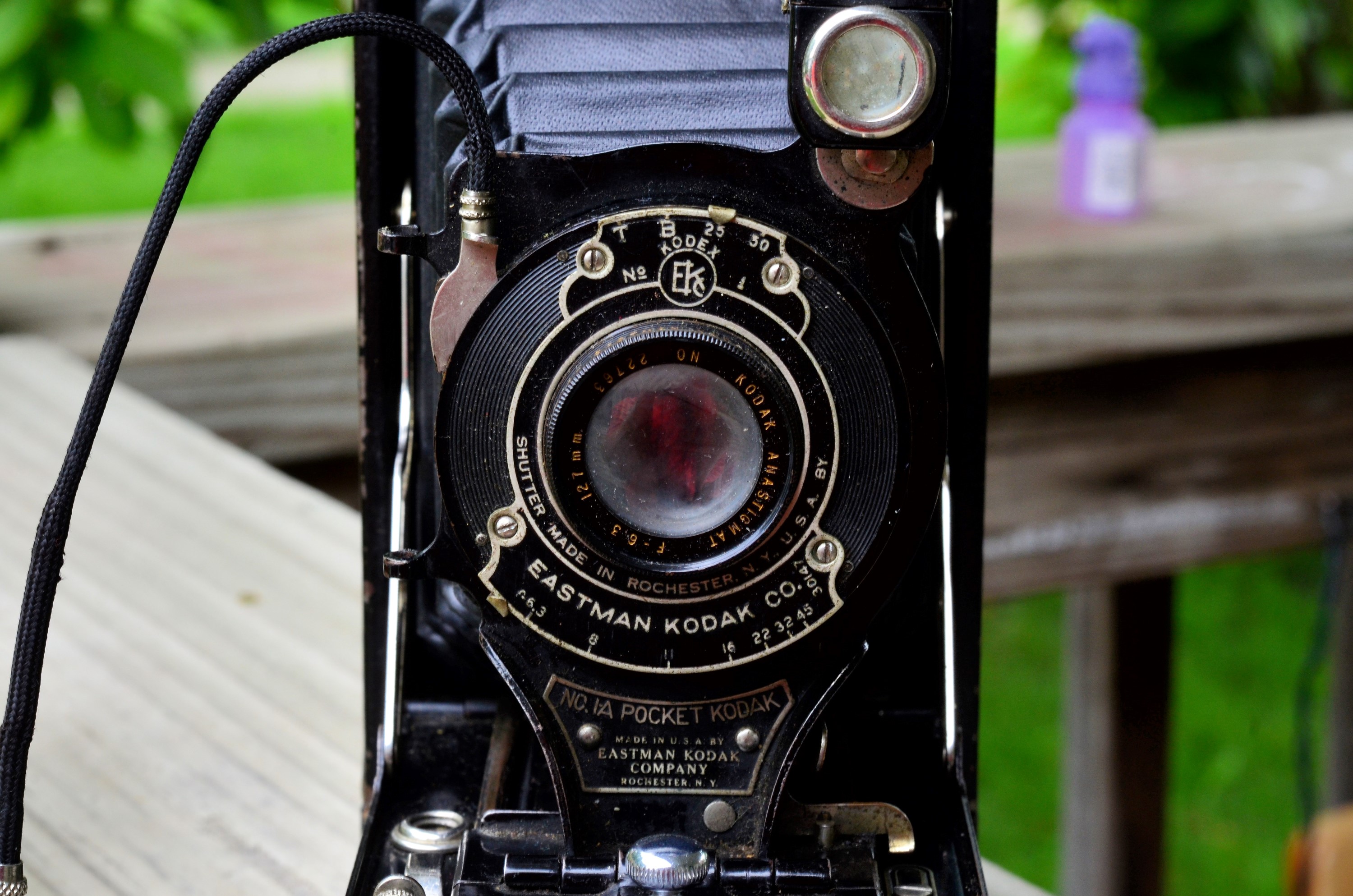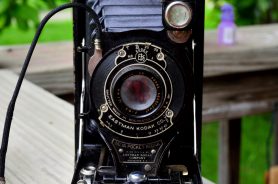
Today, I won an eBay auction for an antique Eastman Kodak folding camera. It’s a “No. 1A Pocket Kodak”. I paid $20 for it. From my research, this camera was sold from 1926 – 1932. Some sites say 1931, some 1932. Although it has the word “pocket” in its name, its still pretty big and would not fit in most pockets. Certainly not a shirt or jeans pocket. An overcoat or large vest pocket maybe.
Anyway, why did I buy this camera? I’m not really sure. I’ve always held some level of fascination for old things. I also like computers and technology too. So when it comes to old technology, in some ways, it appeals to some dark area of my brain, I guess.
I love photography and maybe it’s the simplicity of how things work that attract me to antique technology. You see, these old cameras were incredibly simple. There are absolutely no electronics or moving parts of any kind (other than hinges and the bellows) to wear out. Many of these cameras made around the turn of the last century are still in good working order. For as advanced as modern cameras are today, I suspect that very few, if any will be in good working order 100 years from now. The number one problem that I’ve seen from my research on these old cameras are cracked or broken bellows. If the bellows have holes in them, they will let light into the camera, exposing the film, which ruins it.
In addition to their simplicity, I think these old cameras are beautiful as well. I’ve included a sample picture of the same model camera at the top of this article. There is a lot of shiny brass and curvy pieces of metal in the design of this camera. The design of a folding bellows camera is a wonder to look at. Things were just made differently 100 years ago. Effort was put into every nuance of everything made. Old cash registers were stunning to look at, watches were works of art, even mundane parts of architecture like doorways and chair rails were handcrafted pieces of art. If this camera doesn’t end up working, it would still look great sitting on a shelf.
I don’t intend on letting this thing sit on a shelf, however. I intend on using it. From what I could see of the pictures of the camera in the eBay auction, it appears to be in relatively good shape considering its age. Its hard to tell exactly when my camera was made, but I’ll just guesstimate 1929 since that’s the middle point of the years when this model was sold. Plus 1929 was the year my grandfather was born, so that’s cool too.
I can see in the auction pictures that the bellows is intact. If it does have some small pinholes in the leather, I should be able to patch those with common leather repair products, or even electrical tape. There is some corrosion and oxidation on some of the metal pieces, but I should be able to clean those up with some mild soap and polish. The only thing that really concerns me is the lens, which appears to be cloudy in the pictures. I’ve found sites online talking about repairing these old cameras, and removing the lens shouldn’t be too hard. If I can get it off, I should be able to use simple rubbing alcohol to clean it. As I mentioned earlier, these old cameras are incredibly simple, so I don’t think I’ll have much trouble disassembling it.
The biggest challenge for these old cameras, is film. The model camera I bought used a type of film called Autographic 116 film. Autographic film was discontinued in the 1930s, and 116 film was last made by Kodak in the 1980s. The good news is, that there is a type of film called 120 film which is still made today that can be retrofitted into cameras designed for 116 film. 120 film is a little bit smaller than 116 film, so you can make it work with an adapter. I’ve found several different articles online with suggestions on how to build an adapter. Some of the more wild options including using cut up wall anchors or even circular pieces of a mouse pad.
Whichever way I go, I’m hoping that I wont have much of a problem getting a roll of 120 film into the camera. This camera is capable of shooting either color or black & white photos, but since B&W film is cheaper, I ordered one roll of Ilford HP-5 Plus 400 speed black and white film from Amazon to test out the camera. If I can get some decent photos out of it, I’ll try my luck at more expensive color film.
I’ve been able to find a surprising amount of information about this camera online, including a PDF copy of the original owners manual. The owners manual has detailed instructions on loading and unloading film into the camera, using the camera, and caring for it. You can tell a lot of effort was put into the manual back then as even in the 1920s, photography was still a relatively new technology, and I guess a lot of people didn’t know how to use a camera yet.
I thought this would be a good project to write about and document all of my restoration efforts. A lot of the info I’ve already found online was on small blogs or forums by people like me who are intrigued by these old cameras and wanted to take a stab at getting them to work. Regardless of whether I succeed or fail, it should be interesting. The camera won’t be here until tomorrow, so when I have it in my hands, I will take some detailed pictures before and after. And if, by the end of this project, I am successful at taking some photographs, I will post those as well.
Edit 8/21/2014
The camera arrived today and I took it out of the box. I was very pleased to find that the camera looks to be in great shape. The bellows is almost mint. To be perfectly honest, it looks like it might have been replaced at one point in the past. I can’t believe that an 85 year old piece of folded leather would look this mint.
The camera is dirty and the lens and viewfinder do have some dust inside, but nothing that can’t be cleaned. The shutter fires like it should and everything else seems to be in working order.
Upon opening the camera and looking in the film compartment, I was also pleased to see that the inside of the camera is almost completely dirt free. I am more optimistic than ever that this camera is in good working order and will be able to once again take some new pictures.
Unfortunately, tonight I haven’t had an opportunity to take any good pictures of the camera, but I will definitely get some this weekend and post them.
Edit 8/22/2014
I managed to get some quick photos of the camera. This is exactly how it was sent to me, I have not yet cleaned anything. As you can see, I don’t have a lot to do!
Stay tuned for more…







Did you run some film through it yet and develop it? I’ve managed to run a few rolls of film through a similar one just by threading the film leader into the 116 take up spool and laying the supply spool over in the opposite chamber. The only trick is to only go 5 exposures in, then open the camera in darkness to rewind the film back onto the supply spool for winding through a “normal” 120 camera to be sent off to process. I’ve gotten some surprisingly good results from mine so far, and it excels at night time bulb exposures!
Adam, I have actually run two rolls through my Pocket Kodak. I sacrificed a roll of Ilford HP5 to practice threading, advancing, and rewinding the film. I discovered that I can see the second set of numbers on the backing paper and if I advance the film to the 2 1/2 mark, then 5, 7 1/2, 10, 12 1/2, and 15, I can get 6 shots out of a 120 roll. I’ve done it twice and succeeded at not double exposing any of the frames. I got caught up in writing reviews of my other cameras, but never did a followup to this article. In the meantime, I can email you a couple of the better shots I got back from it.
Cleaning the lens glass is fairly easy, and you don’t have to take the camera apart to do it. I just set the aperture to the largest possible setting, open the shutter on the Time setting, and, from inside, use a lens cleaning tool and compressed air to remove any dirt and dust. I also have experience with taking apart a WWI era pocket folding camera and let me warn you… the leaf shutter is something you don’t want to mess with if you don’t have to. I don’t know how they got those things together to begin with. That’s some pretty complicated machinery in there! I never got mine right again, so it’s a shelf item now.